

Understanding Neo4j Scalability - Understanding Neo4j Scalability(2).pdf. Helping non technical people understand the data. I discovered this interesting question in Enterprise Architecture group in LinkedIn: I'm curious what some of the best practices are to share what information is stored in our database.
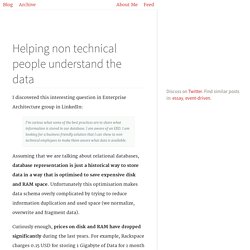
I am aware of an ERD. I am looking for a business friendly solution that I can show to non technical employees to make them aware what data is available. Assuming that we are talking about relational databases, database representation is just a historical way to store data in a way that is optimised to save expensive disk and RAM space. Unfortunately this optimisation makes data schema overly complicated by trying to reduce information duplication and used space (we normalize, overwrite and fragment data). Curiously enough, prices on disk and RAM have dropped significantly during the last years. Yes, we still try to store our data in databases, while accepting all the imposed limitations and cryptic storage schema. Human understanding story does not end here, though.
About this blog. November 30, 2014 I’m taking a few weeks defocused from work, as a kind of grandpaternity leave.
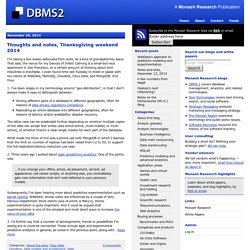
That said, the venue for my Dances of Infant Calming is a small-but-nice apartment in San Francisco, so a certain amount of thinking about tech industries is inevitable. I even found time last Tuesday to meet or speak with my clients at WibiData, MemSQL, Cloudera, Citus Data, and MongoDB. And thus: 1. Storing different parts of a database in different geographies, often for reasons of data privacy regulatory compliance.Replicating an entire database into different geographies, often for reasons of latency and/or availability/ disaster recovery, The latter case can be subdivided further depending on whether multiple copies of the data can accept first writes (aka active-active, multi-master, or multi-active), or whether there’s a clear single master for each part of the database. Non-Relational Databases & Key/Value Stores. That No SQL Thing – Document Databases. Data Points - What the Heck Are Document Databases?
There’s a good chance that you’ve at least heard of the term NoSQL by now.
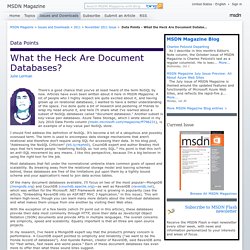
Articles have even been written about it here in MSDN Magazine. A lot of people who I highly respect are quite excited about it, and having grown up on relational databases, I wanted to have a better understanding of the space. I’ve done quite a bit of research and pestering of friends to wrap my head around it, and here I’ll share what I’ve learned about a subset of NoSQL databases called “document databases.” Another subset is key-value pair databases. Azure Table Storage, which I wrote about in my July 2010 Data Points column (msdn.microsoft.com/magazine/ff796231), is an example of a key-value pair NoSQL store. I should first address the definition of NoSQL.
Most databases that fall under the nonrelational umbrella share common goals of speed and scalability. In my research, I’ve heard a MongoDB expert say that the product’s primary concern is performance. RESTful HTTP API—Mostly. Nosql - How to Model Real-World Relationships in a Graph Database (like Neo4j)? Datenmodellierung in nicht relationalen Datenbanken. Längst sind nicht relationale Datenbanken, häufig etwas nichtssagend als „NoSQL“-(Not-only-SQL-)Datenbanken bezeichnet, im technologischen Mainstream und in Real-Life-Projekten angekommen.
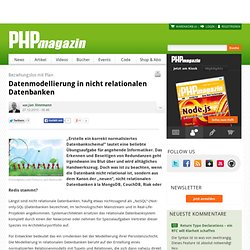
Systemarchitekten ersetzen das relationale Datenbanksystem komplett durch einen der Newcomer oder nehmen für Spezialaufgaben Vertreter dieser Spezies ins Architekturportfolio auf. Für Entwickler bedeutet das ein Umdenken bei der Modellierung ihrer Persistenzschicht. Die Modellierung in relationalen Datenbanken beruht auf der Erstellung eines normalisierten Relationenmodells mit Tupeln und Relationen, die sich dann nahezu direkt in ein Tabellensystem umwandeln lassen. Ranking - popularity ranking of database management systems. Semantic Databases: Destiny Or Distraction? - Software - Databases -
Here's how to decide where flexible semantic technologies can replace more rigid relational systems.
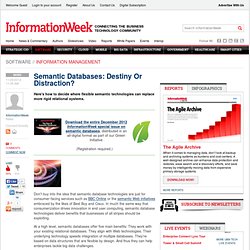
Don't buy into the idea that semantic database technologies are just for consumer-facing services such as BBC Online or the semantic Web initiatives embraced by the likes of Best Buy and Cisco. In much the same way that consumerization drives innovation in end user computing, semantic database technologies deliver benefits that businesses of all stripes should be exploiting. At a high level, semantic databases offer five main benefits: They work with your existing relational databases.
They align with Web technologies. Their underlying technology speeds integration of multiple databases. Their biggest selling point is that data relationships are continually evolving. Connecting these identifiers isn't the end of the task. Our full report, "Semantic Database Technology" is free with registration. This report includes 18 pages of action-oriented analysis, packed with 11 charts. More Insights. SEMTECHBIZ 2013: Semantic Technology & Business Conference.
Flexibility comes first! Db4o. Db4o (database for objects) ist eine Objektdatenbank für die Java- und .NET-Plattform und gehört zu den NoSQL-Datenbanken.
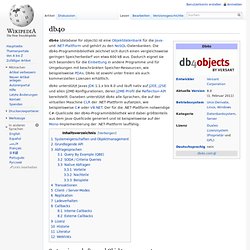
Die db4o-Programmbibliothek zeichnet sich durch einen vergleichsweise geringen Speicherbedarf von etwa 600 kB aus. Dadurch eignet sie sich besonders für die Einbettung in andere Programme und für Umgebungen mit beschränkten Speicher-Ressourcen, wie beispielsweise PDAs. Db4o ist sowohl unter freien als auch kommerziellen Lizenzen erhältlich. Is the Relational Database Doomed? Recently, a lot of new non-relational databases have cropped up both inside and outside the cloud.
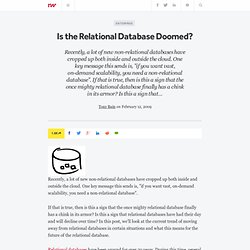
A Comparison of 7 Graph Databases. Introduction to Graph Databases. 5 Graph Databases to Consider. Of the major categories of NoSQL databases - document-oriented databases, key-value stores and graph databases - we've given the least attention to graph databases on this blog.
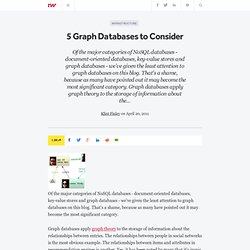
That's a shame, because as many have pointed out it may become the most significant category. Graph databases apply graph theory to the storage of information about the relationships between entries. The relationships between people in social networks is the most obvious example. The relationships between items and attributes in recommendation engines is another. Yes, it has been noted by many that it's ironic that relational databases aren't good for storing relationship data. Google has its own graph computing system called Pregel (you can find the paper on the subject here), but there are several commercial and open source graph databases available. How Facebook’s Entity Graph evolved from plain text to the structured data that powers Graph Search. Software engineer Eric Sun has revealed the evolution of Facebook’s Entity Graph, a complicated data set which maps the 100+ billion connections between people, places and interests.
According to Sun, Facebook’s Entities team was first founded with the task of transforming plain text descriptions in user’s profiles into structured data. In other words, the team had to add meaning to this text in order for the company to do anything with it — this includes everything from selling ads that target your interests to helping you find old friends from high school. In order to do this, Sun says Facebook had to find a data set that let the company represent “the things users had included on their profiles.” The solution was Wikipedia, which powered Facebook’s creation of “millions of ‘fallback’ pages” to match interests that couldn’t be connected to existing pages. These pages then had to be manually vetted for duplicates and ones which didn’t receive any connections were deleted.